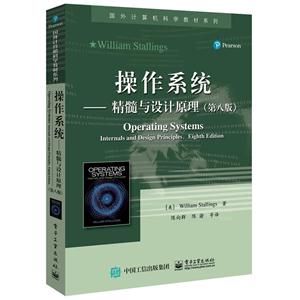-
>
闖進(jìn)數(shù)學(xué)世界――探秘歷史名題
-
>
中醫(yī)基礎(chǔ)理論
-
>
當(dāng)代中國(guó)政府與政治(新編21世紀(jì)公共管理系列教材)
-
>
高校軍事課教程
-
>
思想道德與法治(2021年版)
-
>
毛澤東思想和中國(guó)特色社會(huì)主義理論體系概論(2021年版)
-
>
中醫(yī)內(nèi)科學(xué)·全國(guó)中醫(yī)藥行業(yè)高等教育“十四五”規(guī)劃教材
操作系統(tǒng)-精髓與設(shè)計(jì)原理-(第八版)-英文版 版權(quán)信息
- ISBN:9787121317811
- 條形碼:9787121317811 ; 978-7-121-31781-1
- 裝幀:暫無(wú)
- 冊(cè)數(shù):暫無(wú)
- 重量:暫無(wú)
- 所屬分類:>>
操作系統(tǒng)-精髓與設(shè)計(jì)原理-(第八版)-英文版 本書特色
本書既是關(guān)于操作系統(tǒng)概念、結(jié)構(gòu)和機(jī)制的教材,目的是盡可能清楚和全面地展示現(xiàn)代操作系統(tǒng)的本質(zhì)和特點(diǎn);也是講解操作系統(tǒng)的經(jīng)典教材,不僅系統(tǒng)地講述了操作系統(tǒng)的基本概念、原理和方法,而且以當(dāng)代*流行的操作系統(tǒng)Windows 8、UNIX、Android、Linux為例,展現(xiàn)了當(dāng)代操作系統(tǒng)的本質(zhì)和特點(diǎn)。全書共分背景知識(shí)、進(jìn)程、內(nèi)存、調(diào)度、輸入/輸出和文件、嵌入式系統(tǒng)六部分,內(nèi)容包括計(jì)算機(jī)系統(tǒng)概述、操作系統(tǒng)概述、進(jìn)程描述和控制、線程、并發(fā)性:互斥和同步、并發(fā):死鎖和饑餓、內(nèi)存管理、虛擬內(nèi)存、單處理器調(diào)度、多處理器和實(shí)時(shí)調(diào)度、I/O管理和磁盤調(diào)度、文件管理、嵌入式操作系統(tǒng)、虛擬機(jī)、計(jì)算機(jī)安全技術(shù)、分布式處理、客戶/服務(wù)器和集群等。此外,本書配套網(wǎng)站提供了及時(shí)、生動(dòng)的材料。
操作系統(tǒng)-精髓與設(shè)計(jì)原理-(第八版)-英文版 內(nèi)容簡(jiǎn)介
?Windows 8:詳細(xì)介紹了Windows 8內(nèi)核的各種關(guān)鍵技術(shù)。 ?Android操作系統(tǒng):詳細(xì)介紹了Android移動(dòng)平臺(tái)的限制和運(yùn)行環(huán)境。 ?嵌入式Linux:詳細(xì)介紹了嵌入式Linux的關(guān)鍵要素。 ?虛擬機(jī):新增了虛擬機(jī)操作系統(tǒng)設(shè)計(jì)問(wèn)題的一章。 ?多核設(shè)計(jì)問(wèn)題:增加了關(guān)于操作系統(tǒng)設(shè)計(jì)問(wèn)題的討論。 ?I/O標(biāo)準(zhǔn)化:更新了相應(yīng)的接口內(nèi)容。 ?存儲(chǔ)硬件:更新了存儲(chǔ)硬件部分,包含了固態(tài)硬盤驅(qū)動(dòng)器。 ?容錯(cuò):新增了介紹容錯(cuò)機(jī)制的一節(jié)。
操作系統(tǒng)-精髓與設(shè)計(jì)原理-(第八版)-英文版 目錄
VideoNotes
Preface
About the Author
Chapter 0 Guide for Readers and Instructors 1
0.1 Outline of this Book 2
0.2 Example Systems 2
0.3 A Roadmap for Readers and Instructors 3
0.4 Internet and Web Resources 4
Part 1 Background 7
Chapter 1 Computer System Overview 7
1.1 Basic Elements 8
1.2 Evolution of the Microprocessor 10
1.3 Instruction Execution 10
1.4 Interrupts 13
1.5 The Memory Hierarchy 24
1.6 Cache Memory 27
1.7 Direct Memory Access 31
1.8 Multiprocessor and Multicore Organization 32
1.9 Recommended Reading 36
1.10 Key Terms, Review Questions, and Problems 36
1A Performance Characteristics of Two-Level Memories 39
Chapter 2 Operating System Overview 46
2.1 Operating System Objectives and Functions 47
2.2 The Evolution of Operating Systems 52
2.3 Major Achievements 61
2.4 Developments Leading to Modern Operating Systems 70
2.5 Fault Tolerance 73
2.6 OS Design Considerations for Multiprocessor and Multicore 76
2.7 Microsoft Windows Overview 79
2.8 Traditional UNIX Systems 86
2.9 Modern UNIX Systems 89
2.10 Linux 91
2.11 Android 96
2.12 Recommended Reading and Animations 102
2.13 Key Terms, Review Questions, and Problems 103
Part 2 Processes 105
Chapter 3 Process Description and Control 105
3.1 What Is a Process? 107
3.2 Process States 109
3.3 Process Description 124
3.4 Process Control 133
3.5 Execution of the Operating System 139
3.6 UNIX SVR4 Process Management 142
3.7 Summary 147
3.8 Recommended Reading and Animations 147
3.9 Key Terms, Review Questions, and Problems 148
Chapter 4 Threads 152
4.1 Processes and Threads 153
4.2 Types of Threads 159
4.3 Multicore and Multithreading 166
4.4 Windows 8 Process and Thread Management 171
4.5 Solaris Thread and SMP Management 178
4.6 Linux Process and Thread Management 182
4.7 Android Process and Thread Management 186
4.8 Mac OS X Grand Central Dispatch 190
4.9 Summary 193
4.10 Recommended Reading 193
4.11 Key Terms, Review Questions, and Problems 194
Chapter 5 Concurrency: Mutual Exclusion and Synchronization 199
5.1 Principles of Concurrency 202
5.2 Mutual Exclusion: Hardware Support 210
5.3 Semaphores 214
5.4 Monitors 227
5.5 Message Passing 233
5.6 Readers/Writers Problem 240
5.7 Summary 244
5.8 Recommended Reading and Animations 245
5.9 Key Terms, Review Questions, and Problems 246
Chapter 6 Concurrency: Deadlock and Starvation 259
6.1 Principles of Deadlock 260
6.2 Deadlock Prevention 269
6.3 Deadlock Avoidance 271
6.4 Deadlock Detection 277
6.5 An Integrated Deadlock Strategy 279
6.6 Dining Philosophers Problem 280
6.7 UNIX Concurrency Mechanisms 282
6.8 Linux Kernel Concurrency Mechanisms 286
6.9 Solaris Thread Synchronization Primitives 293
6.10 Windows 7 Concurrency Mechanisms 295
6.11 Android Interprocess Communication 299
6.12 Summary 300
6.13 Recommended Reading and Animations 301
6.14 Key Terms, Review Questions, and Problems 302
Part 3 Memory 309
Chapter 7 Memory Management 309
7.1 Memory Management Requirements 310
7.2 Memory Partitioning 314
7.3 Paging 325
7.4 Segmentation 328
7.5 Summary 330
7.6 Recommended Reading and Animations 330
7.7 Key Terms, Review Questions, and Problems 330
7A Loading and Linking 333
Chapter 8 Virtual Memory 340
8.1 Hardware and Control Structures 341
8.2 Operating System Software 358
8.3 UNIX and Solaris Memory Management 377
8.4 Linux Memory Management 383
8.5 Windows Memory Management 386
8.6 Android Memory Management 389
8.7 Summary 389
8.8 Recommended Reading and Animations 390
8.9 Key Terms, Review Questions, and Problems 391
Part 4 Scheduling 397
Chapter 9 Uniprocessor Scheduling 397
9.1 Types of Processor Scheduling 398
9.2 Scheduling Algorithms 402
9.3 Traditional UNIX Scheduling 424
9.4 Summary 426
9.5 Recommended Reading and Animations 427
9.6 Key Terms, Review Questions, and Problems 428
Chapter 10 Multiprocessor, Multicore, and Real-Time Scheduling 432
10.1 Multiprocessor and Multicore Scheduling 433
10.2 Real-Time Scheduling 446
10.3 Linux Scheduling 461
10.4 UNIX SVR4 Scheduling 465
10.5 UNIX FreeBSD Scheduling 466
10.6 Windows Scheduling 470
10.7 Summary 472
10.8 Recommended Reading 473
10.9 Key Terms, Review Questions, and Problems 473
Part 5 Input/Output and Files 477
Chapter 11 I/O Management and Disk Scheduling 477
11.1 I/O Devices 478
11.2 Organization of the I/O Function 480
11.3 Operating System Design Issues 483
11.4 I/O Buffering 486
11.5 Disk Scheduling 489
11.6 RAID 496
11.7 Disk Cache 505
11.8 UNIX SVR4 I/O 509
11.9 Linux I/O 512
11.10 Windows I/O 515
11.11 Summary 517
11.12 Recommended Reading and Animations 518
11.13 Key Terms, Review Questions, and Problems 519
Chapter 12 File Management 522
12.1 Overview 523
12.2 File Organization and Access 529
12.3 B-Trees 533
12.4 File Directories 536
12.5 File Sharing 541
12.6 Record Blocking 542
12.7 Secondary Storage Management 544
12.8 UNIX File Management 552
12.9 Linux Virtual File System 557
12.10 Windows File System 561
12.11 Android File Management 566
12.12 Summary 567
12.13 Recommended Reading 568
12.14 Key Terms, Review Questions, and Problems 568
Part 6 Embedded Systems 571
Chapter 13 Embedded Operating Systems 571
13.1 Embedded Systems 572
13.2 Characteristics of Embedded Operating Systems 573
13.3 Embedded Linux 576
13.4 TinyOS 577
13.5 Recommended Reading 587
13.6 Key Terms, Review Questions, and Problems 587
Chapter 14 Virtual Machines 590
14.1 Approaches to Virtualization 593
14.2 Processor Issues 596
14.3 Memory Management 598
14.4 I/O Management 600
14.5 VMware ESXi 602
14.6 Microsoft Hyper-V and Xen Variants 604
14.7 Java VM 606
14.8 Linux VServer Virtual Machine Architecture 606
14.9 Android Virtual Machine 609
14.10 Summary 611
14.11 Recommended Reading 612
14.12 Key Terms, Review Questions, and Problems 613
Chapter 15 Operating System Security 614
15.1 Intruders and Malicious Software 615
15.2 Buffer Overflow 619
15.3 Access Control 627
15.4 UNIX Access Control 635
15.5 Operating Systems Hardening 638
15.6 Security Maintenance 642
15.7 Windows Security 643
15.8 Summary 648
15.9 Recommended Reading 649
15.10 Key Terms, Review Questions, and Problems 649
Chapter 16 Distributed Processing, Client/Server, and Clusters 652
16.1 Client/Server Computing 653
16.2 Distributed Message Passing 664
16.3 Remote Procedure Calls 667
16.4 Clusters 671
16.5 Windows Cluster Server 676
16.6 Beowulf and Linux Clusters 678
16.7 Summary 680
16.8 Recommended Reading 681
16.9 Key Terms, Review Questions, and Problems 682
Appendices
Appendix A Topics in Concurrency A-1
Appendix B Programming and Operating System Projects B-1
References 685
Credits 699
Online Chapters and Appendices1
Chapter 17 Network Protocols
17.1 The Need for a Protocol Architecture 17-4
17.2 The TCP/IP Protocol Architecture 17-9
17.3 Sockets 17-19
17.4 Linux Networking 17-26
17.5 Summary 17-29
17.6 Recommended Reading and Web Sites 17-30
17.7 Key Terms, Review Questions, and Problems 17-31
17A The Trivial File Transfer Protocol 17-42
Chapter 18 Distributed Process Management
18.1 Process Migration 18-2
18.2 Distributed Global States 18-14
18.3 Distributed Mutual Exclusion 18-22
18.4 Distributed Deadlock 18-41
18.5 Summary 18-59
18.6 Recommended Reading 18-60
18.7 Key Terms, Review Questions, and Problems 18-61
Chapter 19 Overview of Probability and Stochastic P
操作系統(tǒng)-精髓與設(shè)計(jì)原理-(第八版)-英文版 作者簡(jiǎn)介
William Stallings:美國(guó)圣母大學(xué)電子工程學(xué)士,麻省理工學(xué)院計(jì)算機(jī)科學(xué)博士,《密碼術(shù)》期刊編委。美國(guó)多家高科技公司執(zhí)行總監(jiān),政府機(jī)構(gòu)、計(jì)算機(jī)軟/硬件供應(yīng)商顧問(wèn);曾為各種計(jì)算機(jī)和操作系統(tǒng)設(shè)計(jì)并實(shí)現(xiàn)TCP/IP和OSI協(xié)議套件;創(chuàng)建并維護(hù)了計(jì)算機(jī)科學(xué)專業(yè)學(xué)生資源網(wǎng)站ComputerScienceStudent.com。出版圖書17種,內(nèi)容涉及計(jì)算機(jī)安全、計(jì)算機(jī)網(wǎng)絡(luò)和計(jì)算機(jī)系統(tǒng)結(jié)構(gòu)等;在《IEEE進(jìn)展》《ACM計(jì)算評(píng)論》和《密碼術(shù)》等雜志上發(fā)表文章多篇;先后12次獲美國(guó)年度*計(jì)算機(jī)科學(xué)教科書獎(jiǎng)和學(xué)術(shù)作者協(xié)會(huì)獎(jiǎng)。
- >
唐代進(jìn)士錄
- >
名家?guī)阕x魯迅:故事新編
- >
史學(xué)評(píng)論
- >
上帝之肋:男人的真實(shí)旅程
- >
有舍有得是人生
- >
大紅狗在馬戲團(tuán)-大紅狗克里弗-助人
- >
企鵝口袋書系列·偉大的思想20:論自然選擇(英漢雙語(yǔ))
- >
煙與鏡


















